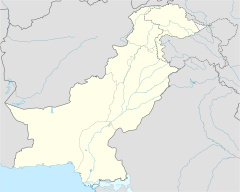Mithankot facts for kids
Quick facts for kids
Mithan Kot
مِٹهّن كوٹ |
|
|---|---|

The tomb of Khawaja Ghulam Fareed is located in Mithankot
|
|
| Country | |
| Province | |
| District | Rajanpur |
| Division | Dera Ghazi Khan Division |
| Population
(2017 census)
|
|
| • Total | 37,500 |
| Time zone | UTC+5 (PST) |
| Postal code |
33600
|
| Calling code | 0604 |
Mithankot (Urdu: مِٹھّن کوٹ) also known as Kotmithan orThe Land of Five Rivers, is a city in Rajanpur District in Punjab, Pakistan. Mithankot is located on the west bank of the Indus River, a short distance downstream from its junction with Panjnad River. Most of its inhabitants are Saraikis and Baloch. The city is noted for being the site of the tomb of the famous Sufi poet, Khawaja Ghulam Fareed.Kot Mithan is also the land, where all five rivers of Pakistan merges.
Contents
Name
It seems to be originated after Mitha. It believed that Mithan Kot was founded by a man named Mithan Khan. He was Jatoi by caste and hailed from Paray Wali which was a small town in Seet Pur.
History
It is believed that in 325 BCE Alexander the Great founded a city called Alexandria on the Indus at the site of the last confluence of Punjab rivers with the Indus.Nevertheless, some historians believe that Uch predates the advent of Bikramjit when Jains and Buddhists ruled over the area, and that Mithankot or Chacharan Sharif was the true settlement of Alexandria. Alexander Cunningham writes that in describing the geography of Multan it is necessary to bear in mind the great changes that have taken place in the courses of all the large rivers that flow through the province. In the time of Timur and Akbar the junction of the Chenab and Indus took place opposite Uchh, 60 miles above the present confluence at Mithankot. It was unchanged when Rennell wrote his 'Geography of India,' in a.d. 1788, and still later in 1796, when visited by Wilford's surveyor : [p. 221]: Mirza Mogal Beg. But early in the present century the Indus gradually changed its course, and leaving the old channel at 20 miles above Uchh, continued its course to the south-south-west, until it rejoined the old channel at Mithankot. H.A. Rose writes that The four chief khalifas of Qiblā,-i-Alim were : Nur Muhammad II, of Hajipur or Narowala, in tahsil Rajanpur, Qāzi Muhammad Aqil, of Chācharān Sharif, Hafiz Muhammad Jamal, Multāni, and Khwāja Muhannnad Sulaiman Khan, of Taunsa Sharif, in tahsil Sanghai. Muhammad Aqil's shrine was at Kot Mithan, but, when Ranjit Singh conquered the Derajat, Khawaja Khuda Bakhsh, Mahbub Ilahi, his descendant, settled at Chacharan Sharif, which may now be regarded as the head- quarter of the Bahawalpur State religion. Muhammad Aqil displayed many miracles and in his old age, owing to his spiritual enlightenment, had no shadow; so he used to come out of his house on dark nights only, in order to conceal his sanctity. A cloth (luugi) which passed through his body is kept as a relic to this day.
Climate and economy
The climate is arid and desert-like, the average annual rainfall being only 4 inches (100 mm). Varying extremities in temperature depending on the season. To the south side is the great Indus River.
The cultivation of crops such as wheat, sugarcane, cotton and rice is enabled through irrigation from the canals from the Indus.
Places to visit
- Tomb of Khawaja Ghulam Farid
- Indus Queen ship



